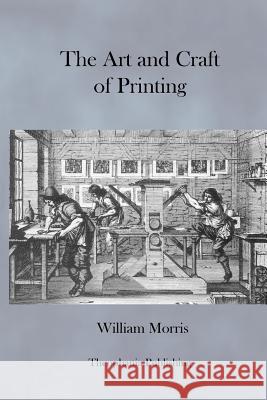The Art and Craft of Printing » książka
The Art and Craft of Printing
ISBN-13: 9781470101268 / Angielski / Miękka / 2012 / 96 str.
The Art and Craft of Printing
ISBN-13: 9781470101268 / Angielski / Miękka / 2012 / 96 str.
(netto: 58,09 VAT: 5%)
Najniższa cena z 30 dni: 60,99
ok. 16-18 dni roboczych
Bez gwarancji dostawy przed świętami
Darmowa dostawa!
Thank you for checking out this book by Theophania Publishing. We appreciate your business and look forward to serving you soon. We have thousands of titles available, and we invite you to search for us by name, contact us via our website, or download our most recent catalogues. I began printing books with the hope of producing some which would have a definite claim to beauty, while at the same time they should be easy to read and should not dazzle the eye, or trouble the intellect of the reader by eccentricity of form in the letters. I have always been a great admirer of the calligraphy of the Middle Ages, & of the earlier printing which took its place. As to the fifteenth-century books, I had noticed that they were always beautiful by force of the mere typography, even without the added ornament, with which many of them are so lavishly supplied. And it was the essence of my undertaking to produce books which it would be a pleasure to look upon as pieces of printing and arrangement of type. Looking at my adventure from this point of view then, I found I had to consider chiefly the following things: the paper, the form of the type, the relative spacing of the letters, the words, and the lines; and lastly the position of the printed matter on the page. It was a matter of course that I should consider it necessary that the paper should be hand-made, both for the sake of durability and appearance. It would be a very false economy to stint in the quality of the paper as to price: so I had only to think about the kind of hand-made paper. On this head I came to two conclusions: 1st, that the paper must be wholly of linen (most hand-made papers are of cotton today), and must be quite 'hard, ' i. e., thoroughly well sized; and 2nd, that, though it must be 'laid' and not 'wove' (i. e., made on a mould made of obvious wires), the lines caused by the wires of the mould must not be too strong, so as to give a ribbed appearance. I found that on these points I was at one with the practice of the paper-makers of the fifteenth century; so I took as my model a Bolognese paper of about 1473. My friend Mr. Batchelor, of Little Chart, Kent, carried out my views very satisfactorily, and produced from the first the excellent paper, which I still use.
Zawartość książki może nie spełniać oczekiwań – reklamacje nie obejmują treści, która mogła nie być redakcyjnie ani merytorycznie opracowana.











